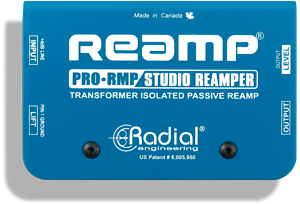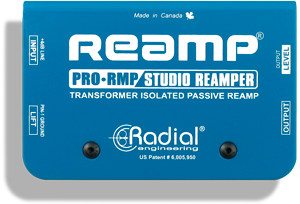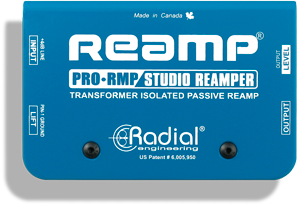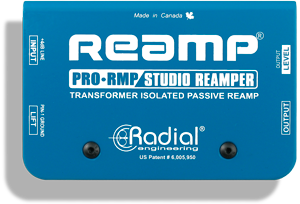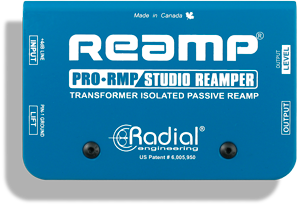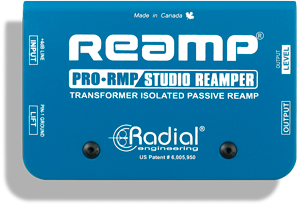Hey,
I recently did a recording of a local punk band and miced their Mesa Boogie half-stacks, but also took a direct signal from their guitars and recorded thawt straight into the soundcard. Now that I have these tracks that are just guitar ittno direct box, how do I get them back to the amp at a reasonable level? My direct box is really just a "Mic Eliminator" which is active, so I don't think it goes both ways. If I get a normal Direct box that is passive, can I just use this backwards? I know there are a couple of products just for this, are they expensive? Are they really different than any other direct box?
Thanks,
Ian
Comments
- Log in or register to post comments
I would also be interested in figuring out how the reamp works a
I would also be interested in figuring out how the reamp works and how I could make a simplified version that just takes my +4 out to a guitar amp. I know quite a bit of basic electronics, but not enough to just figure it out on my own. So what does the reamp do electronically? Does it just match gain and impedence? Does it use a transformer to do this?
Ian
I'm just now realizing that this post started with a punk band p
I'm just now realizing that this post started with a punk band playing through mesa boogies! :roll:
But the old punks certainly appreciated fine gear- lots of Les Pauls, Flying V's, and that, mostly through Marshalls.
I always thought a little combo amp would be more "punk" than an arena rig, but I must still be a little unclear on what's punk.
Ted :confused:
Ted, What a lot of people call "punk" now is very different fro
Ted,
What a lot of people call "punk" now is very different from the original punk. I don't know how to explain it, but I guess some of the "new punk" bands would be Pennywise, NOFX, The Ataris, Blink 182 (mainstream). Anyway, this "punk" I recorded was by a bunch of sophmores in high school whose parents had bought them some pretty nice stuff. They were actually very good at what they played, which I guess isn't very punk either! I guess the reason why I took a direct out of these guy's amps in the first place was so that I could send their tracks to my Marshall JCM800. I know what a pad does, but can one be made easily?
Ian
Actually the old SF punks were very good at what they did, and h
Actually the old SF punks were very good at what they did, and had rigorous standards for tone and unflagging energetic precise performance. Just their horizons were a bit limited... I think "Communication Breakdown" was the model, and a a certain classic punk guitar solo (the solos were the first to go, then later unrelenting intensity became optional as well) is basically modeled after that one- check out the solo on the Bad Brains' "Sailing On".
I'll post a link to some do it yourself pad instructions. The fanatic thing to do would be to have a switchable set of pads- a stepped attenuator. What might work perfectly well is a continuous passive attenuator with a potentiometer. Not sure how to make one of these, but I have one that comes in handy in a number of situations.
Ted
Originally posted by Bear's Gone Fission: If there is that litt
Originally posted by Bear's Gone Fission:
If there is that little to it, we could naturally try to trick it out with a splitter, say, for parallel processing.Bear
Bear, why not mult the direct gtr track output to 2 high quality passive DI and variable pad setups if you want to feed two amps? Unless your recorder has a really flimsy output stage it should be able to handle the load. If worst comes to worst you could do two passes with different amp setups. ;) :p :w:
i just built a reamp box a couple months ago. it is possibly the
i just built a reamp box a couple months ago. it is possibly the simplest electronics project next to repairing cables. it is basically a transformer hooked up to some variable resistors. well... not 'basically'... it IS a transformer hooked up to a couple of variable resistors.
here's the schematic:
http://www.jensen-transformers.com/as/as092.pdf
it has two dials: one for level matching and one for impedence matching and a ground lift switch. it's a passive device.
i used the jensen tranformer but you could likely swap in a cheaper one if you wanted. project cost me $100 Canadian ($90 of which was the transformer).
just used it last week... works great.
there are a host of schematics on the jensen site:
http://www.jensen-transformers.com/apps_sc.html
greg
Thanks for the responses. The very same #092-pdf was already
Thanks for the responses.
The very same #092-pdf was already on my table, together with I thought #04. In a book about guitar-electronics I've found some interesting impedance characteristics for several pickups,
so by adding say a cap and a coil the resonance of the impedance could be added as well.
Point is, when it works & sounds OK is _IS_ OK, but when I try to understand the function of adding the impedance when sending the signal back to the amp, I can only conclude it wouldn't be necessary.
Because: when DIY-ing the gtr (as when recording it dry to tape/disk) the influence of impedance is already taken into account. Note that I would do it like this: plug gtr into a very Hi-Z DI and feed/copy the direct (pre-DI) dry signal to the amp as well.
This way the DI is already 'sniffing' the interaction between gtr & amp-input. When reamping, all that seems to be needed is taking care the same voltage is present again at the amplifier-input.
Any oversights here ?
Thanks,
Peter
Originally posted by coysoundnyc: I know it's expensive (about
Originally posted by coysoundnyc:
I know it's expensive (about 1g) but is way more than a reamp box....Millennia TD1.
I had to mention because I am a reamp freak and I am dreaming about this piece, sooner or later.
I received an E Mail from Millennia this morning regarding the TD 1. They say they are very backordered on the TD 1 at the moment but they promised me a unit as soon as they can get one to me.. Watch for a review.. Kurt
Originally posted by Peter Vermeeren: Because: when DIY-ing
Originally posted by Peter Vermeeren:
Because: when DIY-ing the gtr (as when recording it dry to tape/disk) the influence of impedance is already taken into account. Note that I would do it like this: plug gtr into a very Hi-Z DI and feed/copy the direct (pre-DI) dry signal to the amp as well.This way the DI is already 'sniffing' the interaction between gtr & amp-input. When reamping, all that seems to be needed is taking care the same voltage is present again at the amplifier-input.
Peter, i'm not really sure what you are getting at here but it's the impedance differential between the recording device's output, DAW or tape deck... Low Z and the guitar amp's input... High Z... that will be problematic when you go to rerecord the signal later. I notice a change in the tonal character and noise level even when i make adjustments to the pot controlling impedance on the jensen reamplification box... subtle but present.
I apologize if what i am stating is obvious... and certainly no one can argue with the "if it sounds good it is good" approach... if whatever you are doing is working then why add another box to the equation :)
greg
Originally posted by teleharmonic: ... and certainly no one can
Originally posted by teleharmonic:
... and certainly no one can argue with the "if it sounds good it is good" approach... if whatever you are doing is working then why add another box to the equation :)greg [/QB]
except... of course... by adding another box to the equation you get to buy another box...
and then explain to all your bored looking friends what that little box is doing.
Peter, i'm not really sure what you are getting at here but it's
Peter, i'm not really sure what you are getting at here but it's the impedance differential between the recording device's output, DAW or tape deck... Low Z and the guitar amp's input... High Z... that will be problematic when you go to rerecord the signal later. I notice a change in the tonal character and noise level even when i make adjustments to the pot controlling impedance on the jensen reamplification box... subtle but present.
First of all, thanks for the responses, interesting subject.
W.r.t. impedance, I think there are two sides:
* First one is the actual adjustment/matching of the sending ('+4dBm') to the amp-input. I must admit I can't see any impedance problem involved - as long as the level is right and the signal is unbalanced and the plugs fit physically :-)
I mean, I couldn't imagine a problem using a Hi-Z load for a source that now sees the Hi-Z instead of the usual 10k (or 600 Ohms) it usually sees. I may be wrong here, but higher loads (more Ohms) wouldn't hurt I guess.
* The second point is that the Re-Amp doesn't seem to address the 'real' source-impedance influence of guitar-pickups. Source impedance of a pickup is usually 'flat' (say 8 kOhms) and then has a sharp resonance peak at a few kHz.
Pickups can be made with this peak above the audible range but it would be a dull pickup, without much ;character'.
The TD-1 does seem to mimic this impedance-shape, with its Strat & LesPaul-outputs.
This second side of the impedance-story was the one I was having trouble-to-understand with: as I see it, the influence of this impedance-curve is already taken into account when recording the dry track - as long as it's done as described: using a DI with a very Hi-Z input and which senses the connection going to the amp. I'd say this arrangement already 'senses' the interaction between the guitar-pickups and the amp.
Bye,
Peter
I tried out a bunch of the different units on the market (before
I tried out a bunch of the different units on the market (before the TD-1 was available), and the Little Labs stuff took the cake for me. I got the PCP and the Redeye, and I often wonder how I got along without them, especially for simple guitar pedal stuff. Highly recommended.
anyways I see a reamp like something that goes form +4 to -10 an
anyways I see a reamp like something that goes form +4 to -10 and possibly lower.
too easy?
I guess that's indeed all there is to it.
Anything else in addition I couldn't really understand - unless some toneshaping is to be parked inside the re-amp box itself already.
Peter
Originally posted by Peter Vermeeren: * First one is the actual
Originally posted by Peter Vermeeren:
* First one is the actual adjustment/matching of the sending ('+4dBm') to the amp-input. I must admit I can't see any impedance problem involved - as long as the level is right and the signal is unbalanced and the plugs fit physically :-)
As i understand it, the issue is that you are sending a low z source signal (low voltage, high current) to the amp which is expecting a hi z input (high voltage, low current).
So while you won't get the signal degradation that you get sending a high z signal into a low z input (guitar into mixing board without DI) you will have a voltage deficiency/weak signal which might result in additional noise/hiss . So while the guitar amp will 'see' all the frequencies,as you are suggesting, it will see them as very small. Which may add noise when you turn your guitar amp up.
Originally posted by Peter Vermeeren:
When reamping, all that seems to be needed is taking care the same voltage is present again at the amplifier-input.
This is just the issue... there will not be enough signal present even though the level might be fine... hence noise.
I would imagine that the degree to which this is a problem would depend greatly upon how well your guitar amp input is able to deal with the low voltage signal you are sending it. So it may sound fine without a reamp box if your amp is particularily forgiving... and i have heard of this happening.
Someone please correct me if i am mistaken as i am not an electrical engineer!
cheers,
greg
[ December 18, 2003, 03:13 PM: Message edited by: teleharmonic ]
quote: --------------------------------------------------------
quote:
--------------------------------------------------------------------------------
Originally posted by Peter Vermeeren:
* First one is the actual adjustment/matching of the sending ('+4dBm') to the amp-input. I must admit I can't see any impedance problem involved - as long as the level is right and the signal is unbalanced and the plugs fit physically :-)
--------------------------------------------------------------------------------from Greg:
As i understand it, the issue is that you are sending a low z source signal (low voltage, high current) to the amp which is expecting a hi z input (high voltage, low current).
A signal can be both high in level _and_ having a low source impedance. Best example is a power amp: the level is high and the internal impedance of the amplifier is low, very low (hence capable of driving & controlling the speaker well, but let's skip damping ratio for now).
This is just the issue... there will not be enough signal present even though the level might be fine... hence noise.Level and signal are the same. Determined/defined by the voltage as measured at thoat point.
This is not about power here, despite the link of the re-amp to 600 Ohm lines. Matching of source and load impedances of 600 Ohms each was done in the past to maximize power-transfer.
...to the amp which is expecting a hi z input (high voltage, low current).
Today it's all about voltage transfer and I guess for newly designed gear, 600 Ohm is in fact not taken into account/used/considered anymore.
The rule of thumb here is that things will do fine as long as the total load impedance is ten times the source impedance.
Someone please correct me if i am mistaken as i am not an electrical engineer!IMHO I don't think your points are valid. The thing is, I am an EE but right now I can't think of a better way to explain this issue any better than my attempts above :-)
Bye,
Peter
Originally posted by Peter Vermeeren: IMHO I don't think your
Originally posted by Peter Vermeeren:
IMHO I don't think your points are valid. The thing is, I am an EE but right now I can't think of a better way to explain this issue any better than my attempts above :-)
That's fine Peter, it is quite possible that my theoretical understanding is invalid:-)at the least it is incomplete.
What i do know from experience is that, with my guitar amp and my DAW, simple level matching does not yield an acceptable sound.
When i send a signal from my DAW directly to my amp i get an unpleasant and noisy sound no matter how much i adjust the level, when i do the same thing with the jensen reamp box i built i get a much cleaner, fuller sound.
While i may be able to move enough voltage from the DAW to the amp what it sounds like to me is that i am not getting enough signal in the form of guitar tone. I am getting signal and a bunch of noise.
I was under the impression that the reamp box works due to the fact that the transformer was converting the impedance to a level which my amp could better handle. Since i know that the issue is not merely the level the idea that impedance must come into play makes sense to me... i was also under the impression that this was the whole reason for the "reamp" box as a product in the first place. :)
you mention that modern gear is all about level matching and perhaps the reason i am not experiencing this is because i am not actually using a modern amp, but and old fender. i dunno.
I will continue to use the reamp transformer simply because it sounds better when i do so... even if the box was full of sand and that made a difference i would do it! but if someone could explain the theory better for me i would sure like to understand it...
cheers,
greg
:)
[ December 19, 2003, 03:12 PM: Message edited by: teleharmonic ]
Getting a Reamp versus using a passive direct box The Radial JD
Getting a Reamp versus using a passive direct box
The Radial JDI direct box is sometimes suggested as a alternative to a proper Reamp. Although this is true, this may not be the best option. A passive Reamp and direct box like the JDI both employ a transformer as the motor that does the work. A direct box transformer is designed to capture an instrument level source - say between -20dB and -10dB and then convert the signal down to -30db or about the same level as a microphone. This enables the DI box to connect to a mic splitter on a stage or the mic input on a mixer or preamp. On a stage, having the ability to quickly swap cables around without worrying about signal levels can save a lot of time when trouble shooting. A Reamp is designed to take a +4dB line level source and bring it down to a guitar level (say -20dB) so that it sounds right in a guitar amp. Reamps all have variable output levels to compensate as needed.
The difference here is the type of transformer being used. With an instrument, a direct box transformer such as a Jensen JT-DBE has a 12:1 step-down turn ratio that no only changes the level and impedance, it also balances the signal. This is designed for instrument levels. Inside a Reamp, a 1:1 line level transformer is typically employed which also serves to unbalance the balanced line level signal from your recording system. You can turn the output level down on your recording system to use a JDI direct box backwards, but this will of course reduce the signal to noise (increase susceptibility to noise). You will also require a turn-around XLR connector to use the output as an input and once set up, this will force you to adjust the level gong into the amp at the console as there will not be a local volume control next to the guitar amp as found on a Reamp. In essence a JDI direct box and a Reamp are in many ways opposites!
Peter Janis - Radial Engineering
I got this one and get good results with my Vox AV60. Not expens
I got this one and get good results with my Vox AV60. Not expensive !
https://www.sweetwater.com/store/detail/ProRMP
I got this one and get good results with my Vox AV60. Not expens
I got this one and get good results with my Vox AV60. Not expensive !
https://www.sweetwater.com/store/detail/ProRMP







